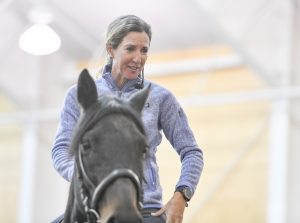 Editor’s Note: Best Horse Practices Summit presenter Katrin Silva grew up riding dressage in Germany before moving to the United States at age 19 to learn to ride Western. She’s been riding both disciplines for the last 20 years and is a regular guest columnist for Cayuse Communications. The author of Dressage for All of Us: How to Help Any Horse Become a Happier, More Responsive Riding Partner and the forthcoming Ride with Feel: A Guide for the Rest of Us lives in New Mexico where she works with dressage and Western clients.
Editor’s Note: Best Horse Practices Summit presenter Katrin Silva grew up riding dressage in Germany before moving to the United States at age 19 to learn to ride Western. She’s been riding both disciplines for the last 20 years and is a regular guest columnist for Cayuse Communications. The author of Dressage for All of Us: How to Help Any Horse Become a Happier, More Responsive Riding Partner and the forthcoming Ride with Feel: A Guide for the Rest of Us lives in New Mexico where she works with dressage and Western clients.
Katrin Silva writes:
There’s a lot of talk about heart, spirit, and emotional connection in today’s horse world – a marked contrast to the buzzwords of decades past, which sounded more like “Show him who’s in boss!” or “Just make him do it!” I am happy about this, but also, sometimes, a little uneasy, a little skeptical.
Why is that?

Katrin Silva will present at the BHPS this fall
Of course, it’s good we are moving away from dominance-based training. When I was very young, I worked for a world champion trainer who used prong bits, draw reins, and rock-grinder spurs to get horses to do what she wanted. These images are etched into my brain, where they will stay until the day I die, as reminders that this is not who I want to be. Thirty years ago, I swore I would never do anything like this to a horse ever again, and I never have. It’s good that our focus today is shifting away from dominating our horses to building relationships with them.
But we can’t build these relationships with our hearts alone. Emotional connection is only a part of the harmony we all crave.
In emphasizing the emotional side of horsemanship, some of us will neglect the physical and intellectual side. Riders and horses are athletes. Without athletic development – theirs and ours – our horses will not be physically able to become willing, responsive riding partners.
If we ride, we have a moral obligation to work on our seat – not because we want to look pretty in the saddle, but to be able to better communicate with our horses. We also have a moral obligation to develop the horse’s body and mind in a way that makes carrying us more comfortable. This means working with our horses almost every day, gradually building their strength, suppleness, stamina, confidence, and focus. Of course, this is much easier to do with a horse who trusts us. Pausing and just breathing with our horses can help build the necessary trust and serve as the basis for all further work. But it’s no substitute for the actual work. There is a lot of truth in the old saying that a good horse comes from many wet saddle pads.

Katrin at the BHPS 2021 Summit
Our rational brain plays a role, too. Without a solid education in the history and theory of good horsemanship, all the feel and connection in the world still may not translate into a solid long-term partnership with our horses. If we don’t know better, without meaning to, we may ask them for the wrong things at the wrong time, or for too much, or for not enough, of the right thing. Without guidelines rooted in tradition and backed by science, it can be difficult to know what is fair and appropriate to ask our horses at any given time, and why. All good, life-long horsemen I know are also life-long students of the horse, willing to adjust what they do based on new evidence.
Building a true partnership with a horse takes commitment, physical effort, emotional maturity, and theoretical knowledge. Yes, please ride with your heart, but take your mind and your body along, too. Your horse will thank you.